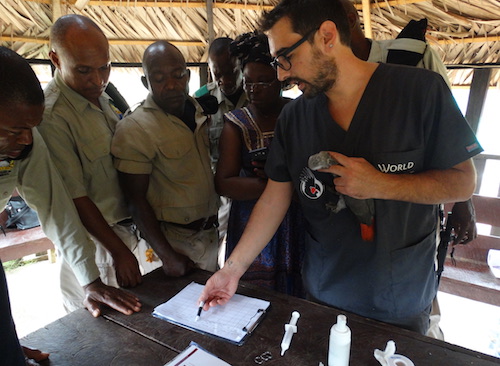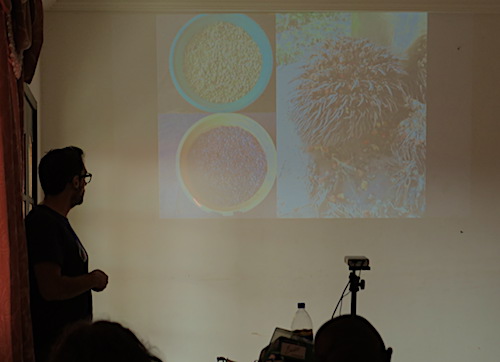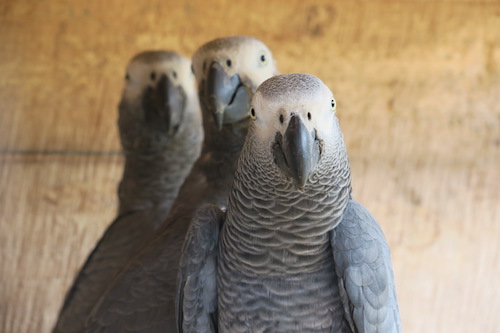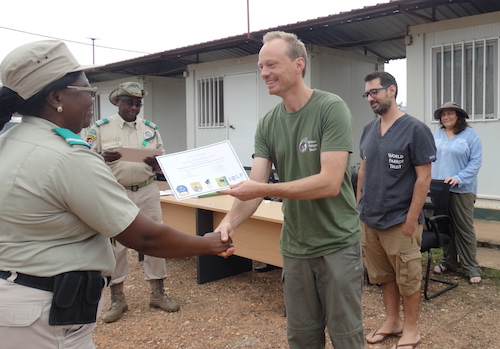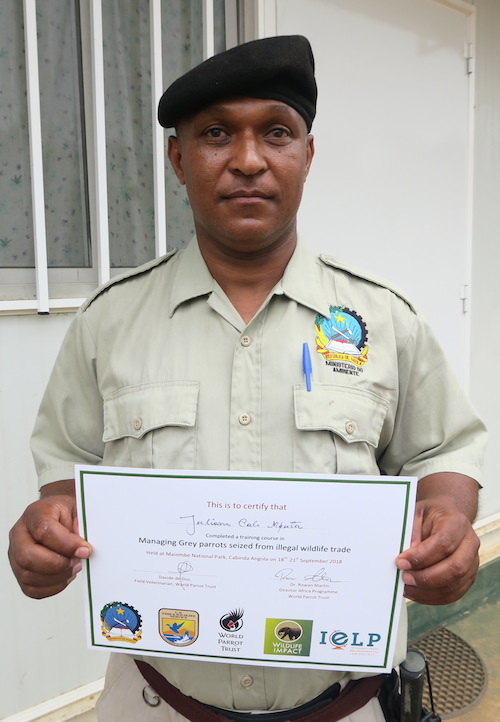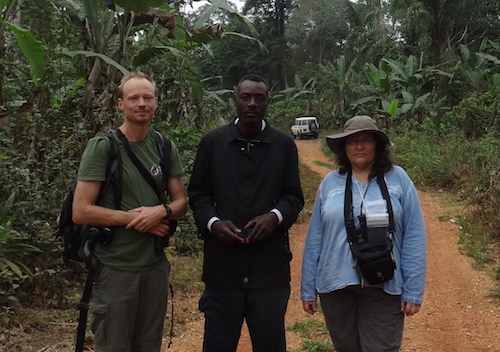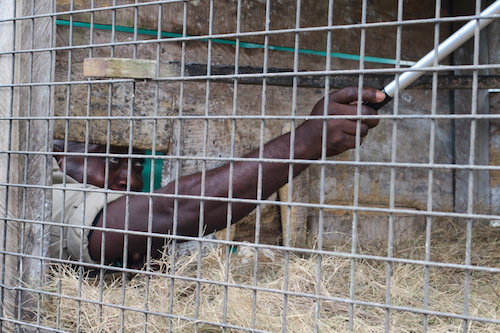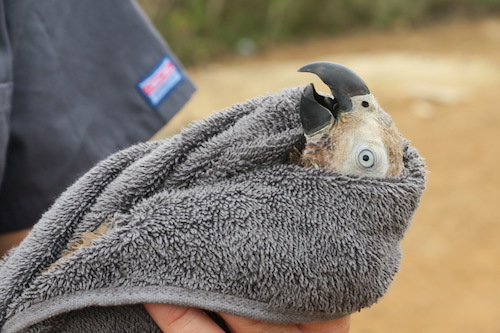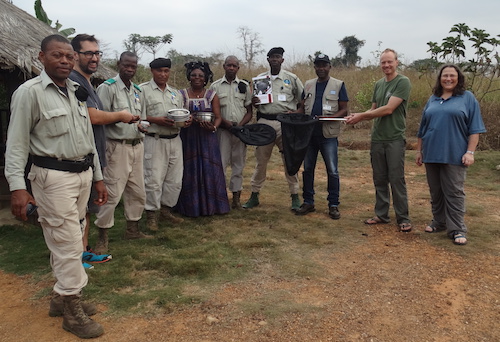The Mayombe forest sits at the south-western margin of the Congo Basin's tropical rainforests. Stretching from coastal Democratic Republic of the Congo (DRC), through the Cabinda Province of Angola, along the western zone of the Republic of Congo and up to south-west Gabon, it supports a bewildering diversity of species. Among them western lowland gorillas, central chimpanzees, forest elephants and….African Grey parrots.
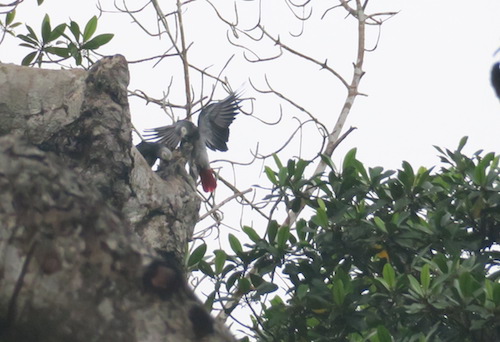
This important area is the focus of one of Africa’s most exciting transfrontier conservation initiatives, which brings together governments to join up conservation efforts in the region. One of the challenges has been the porous borders which mean that traffickers of wildlife can move easily between countries. In Angola, this has impacted Grey parrots, with trappers from the DRC and the Republic of Congo coming to Cabinda province to trap and buy parrots, which are then moved into international trade using falsified permits. The Ministry of the Environment of Angola spoke up passionately about this challenge to CITES (the Convention of Trade in Endangered Species of Wild Flora and Fauna), as part of an effort by the majority of range states to end all legal trade in wild Grey parrots. Recent enforcement efforts have led to poachers being expatriated to the DRC but have also left park rangers with the challenge of what to do with the parrots seized from trade.
As part of a new collaborative initiative between the Ministry of Environment of Angola (MINAMB), the International Environmental Law Project (IELP), the United States Fish and Wildlife Service (USFWS), Wildlife Impact and the World Parrot Trust (WPT), the WPT recently devised and delivered a series of training workshops in Angola. The focus was a three-day workshop delivered to park rangers at the headquarters of Maiombe National Park. These rangers are at the forefront of enforcement efforts and as result are faced with providing care for seized wildlife. Parrots are just one of the groups of animals they encounter - primates and pangolins have also been seized in recent years. Building capacity is vital for ensuring the best outcomes for these animals as well as for supporting the enforcement efforts and maintaining morale among the park staff.
WPT field veterinarian Dr Davide de Guz and Africa programme Director Rowan Martin, delivered training on the basic biology of parrots, their role in ecosystems, the importance of conservation, and the process of rescue and rehabilitation. Rangers were given a chance to gain practical skills, with hands-on experience in how to safely handle parrots, deliver medication and fit leg rings, while minimising stress. Another major component of the course focused on scenario planning. This involved in-depth discussions of the situations encountered by rangers and other enforcement staff in Angola, and the development of locally-appropriate strategies for managing seized parrots.
The final morning of the course was spent considering the future for the parrots already seized from trade and held at the park headquarters. Plans were made for the construction of a new rehabilitation aviary financed by the WPT. Equipment and supplies were also donated including stainless steel feeding bowls, scales, nets, medication and rings.
The course was followed by a series of outreach missions to communities living close to parrot nesting areas to learn more about the connections between communities and wildlife traders from neighbouring countries. These communities are the first line of defence against trappers and traders arriving from outside the region. Plans were also made to integrate the collection of data on wild parrots into new biomonitoring initiatives.
Away from the Maiombe National Park, Dr Davide de Guz also delivered additional training sessions to government technicians in Cabinda city and Luanda and discussions were held with government vets about how to further build local capacity for the care of parrots seized from illegal trade.
Recently, the construction of the new aviary was concluded and the Park staff have moved the parrots to their new home. During the transfer, one escaped but is surviving well and continues to return regularly for food, which it now receives on top of the aviary. As for those kept in the new aviary, until their expected release next year, the Park Manager José Bizi has noted a considerable difference in their appearance and behaviour since their space has increased and their diet diversified. The rangers, on their side, now feel much more confident and motivated in caring for the parrots, carrying proudly the name that all the rangers in Angola have selected to call themselves "soldados da natureza - soldiers of nature".
Building local capacity for the care of parrots seized from trade is a vital part of WPT’s multi-faceted strategy to address the threat of trade in wild parrots in Africa. By providing targeted support WPT can ease the burden on groups on the front line, encouraging enforcement and ensuring parrots get the care they need. In 2018 WPT has supported groups of parrots seized from trade in Guinea, Senegal, Sierra Leone, Angola and DRC.
The World Parrot Trust would like to say a huge thank you to all involved in this project which was designed under the guidance of the Minister of Environment, Her Excellency Paula Francisco Coelho, with its principal consultant, Dr Tamar Ron in collaboration between the Ministry of Environment of Angola, the International Environmental Law Project, the United States Fish and Wildlife Service and Wildlife Impact . The course realization was led by the Maiombe National Park's Manager, José Maria Bizi, and the Park staff, facilitated by Dr Tamar Ron, and supported by MINAMB, the Provincial Government of Cabinda, and the Municipal Administration of Buco-Zau, which also hosted its inauguration and an award ceremony for those who successfully completed the course.
Today the 2018 Illegal Wildlife Trade (IWT) Conference draws to a close in London. At the end of a week of meetings between leaders from around the world, academics, NGOs, local communities and many others, two things are clear: illegal trade is a major threat to wildlife and sustainable livelihoods, and it's imperative that the international community works together to find solutions to often wickedly complex and intertwined problems.
Each year many thousands of parrots are trapped in the wild, destined for life in a cage. Many of these come from Africa, which has the dubious distinction of having three of the top four most-traded birds listed on CITES (1). This threat, combined with the loss of habitat, has sadly seen several African parrots uplisted on the IUCN Red List of threatened species. The global parrot trade is also driving the establishment of non-native species, the spread of diseases and can have distressing consequences for the welfare of the parrots involved (2,3).
Tackling the trade in wild parrots has always been central to the World Parrot Trust’s mission of conserving parrots in the wild. The issues are deeply complex and simple solutions elusive. A multi-faceted and evidence-based approach is essential.
A major theme of the week’s meetings was the critical importance of listening to and engaging with local communities. Engaging with local communities that live alongside important parrot populations is essential for both understanding and addressing threats. In 2018 WPT initiated and supported multiple initiatives involving local communities on the conservation frontline. Last month the first national status assessment for Timneh parrots in Guinea-Bissau was published(4), which was the culmination of several years of hard work by project partners. By visiting and speaking with the communities who live alongside, and in some cases trap, these endangered parrots valuable understanding could be gained. In Sierra Leone a similar approach has enabled new breeding sites and previously unknown strongholds for the species to be identified. In Nigeria surveys have sought to understand the conservation status of wild populations of African Grey parrots as well as the cultural significance and economic value of the species for local communities.
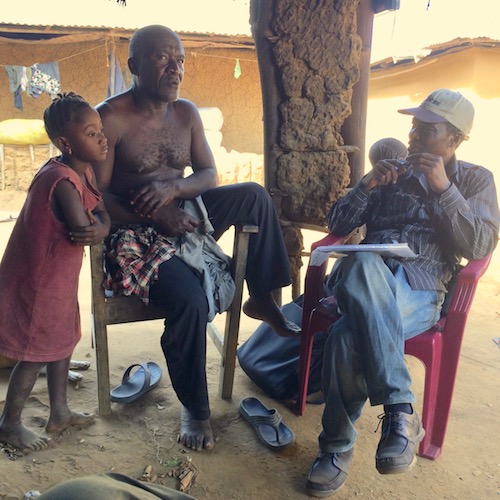
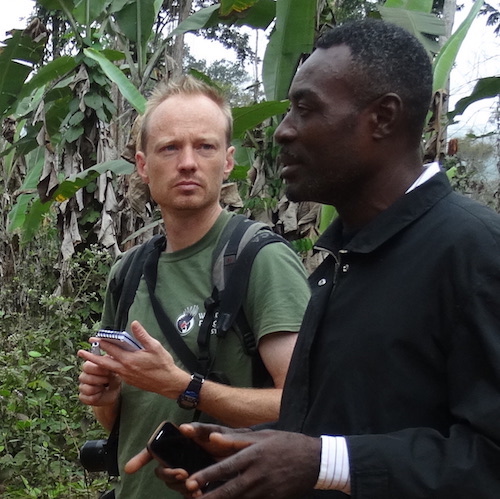
Top: Dr. Okoni-Williams hears from a community leader about Timneh parrots (January 2018, Sierra Leone). Bottom: José Antonio Nhoca explains how trappers come from neighbouring countries looking for African Grey parrots (September 2018, Angola).
Another major theme was the need for a better evidence base on which informed interventions to stop illegal trade can be based. While drawing on local knowledge can be hugely informative, it's also critical to understand global trade chains and the constantly changing dynamics of trade. Another area of WPT research draws on multiple information sources to improve understanding of the changing nature of the global parrot trade and to identify key transport routes and opportunities for enforcement (1,2,5). As well as ensuring our research is published in leading peer-reviewed journals, WPT also works hard to get the right information in front of the right people, preparing reports and meeting with policymakers so that the evidence leads to action.
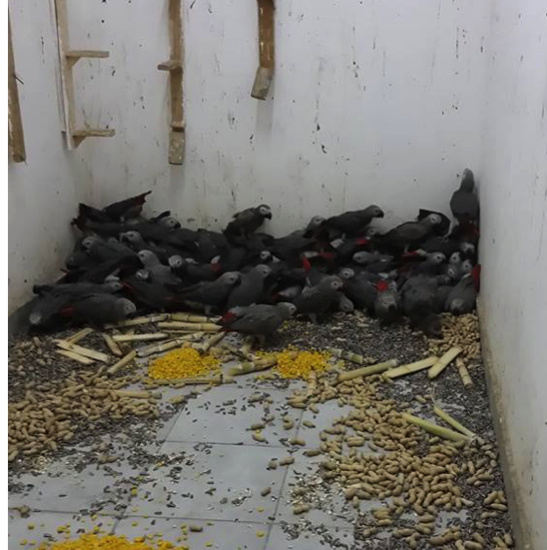
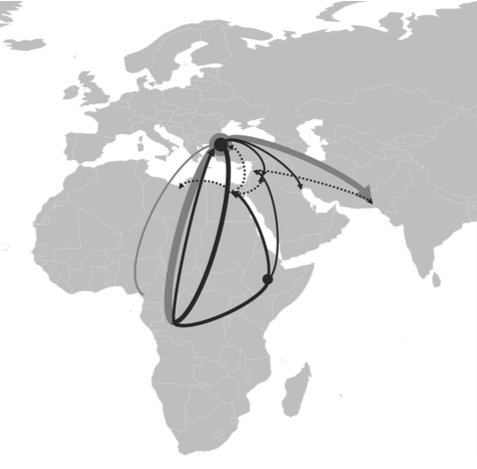
Top. Monitoring of online trade reveals how African Grey parrots are traded providing intelligence for law enforcement. Bottom. Investigations of social media have revealed frequently used illegal trade routes for parrots out of Africa.
Yet another theme was the emergence of cyber-enabled wildlife crime and the rise of social media as a means to trade wildlife. WPT’s trade specialists have been monitoring trade in parrots via social media for several years and sharing intelligence with enforcement agencies. A recent collaboration with World Animal Protection has led to the publication of a ground-breaking study examining the use of social media to trade parrots (2). This emerging threat needs urgently addressing. The recently launched Global Coalition to End Wildlife Trafficking Online, signed by most major tech companies, is an important step in the right direction and specialists in particular taxonomic groups have a vital role to play in assisting this process.
Perhaps the most important discussions to emerge this week were about ways in which a diversity of groups can work together to achieve coordinated and evidence-based action. The parrot trade does not operate in isolation and overlaps with trade in many other species. The legal trade in parrots can provide cover for illegal trade in other species. Only through strong and effective partnerships will we address the threat to wildlife and communities around the world.
WPT IWT research in 2018
1. Martin, R. O. (2018). The wild bird trade and African parrots: past, present and future challenges. Ostrich-Journal of African Ornithology, 1–5. doi:10.2989/00306525.2017.1397787
2. Martin, R. O., Senni, C., and D'Cruze, N. C. (2018). Trade in wild-sourced African grey parrots: Insights via social media. Global Ecology and Conservation, e00429. doi:10.1016/j.gecco.2018.e00429
3. Fogell, D. J., Martin, R. O., Bunbury, N., Lawson, B., Sells, J., McKeand, A. M., Tatayah, V., Trung, C. T., and Groombridge, J. J. (2018). Trade and conservation implications of new beak and feather disease virus detection in native and introduced parrots. Conservation Biology 66, 1005–11. doi:10.1111/cobi.13214
4. Lopes, D. C., Martin, R. O., Henriques, M., Monteiro, H., Cardoso, P., Tchantchalam, Q., Pires, A. J., Regalla, A., and Catry, P. (2018). Combining local knowledge and field surveys to determine status and threats to Timneh Parrots Psittacus timneh in Guinea-Bissau. Bird Conservation International 118, 1–13. doi:10.1017/S0959270918000321
5. Martin, R. O. (2018). Grey areas: temporal and geographical dynamics of international trade of Grey and Timneh Parrots (Psittacus erithacusand P. timneh) under CITES. Emu - Austral Ornithology 118, 113–125. doi:10.1080/01584197.2017.1369854


